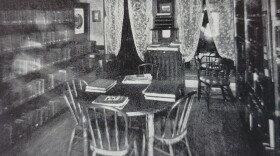Heinrich August Henkelmann or Henry as he was known, was born in Marathon County in 1897. He came from a long line of German foresters and a propensity toward the natural world was in his blood. He grew up in the Town of Hewitt just Northeast of Wausau.
As a young boy Henry mounted a whitetail buck, which was hung in his father’s hunting lodge. Henry was a child prodigy and his natural ability for taxidermy was entirely self taught. Hunters that visited took note of his remarkable lifelike work and requested Henry mount their trophies as well.
After serving in France during the first world war, he would move to the Merrill area with his wife Mary. They opened and operated a log tavern, taxidermy shop, and a small wildlife museum which they built themselves.
Growing up in the forest left an indelible impression on Henry’s young mind and he recreated those environs at every place he lived with an uncanny ability. Using tree bark accenting, and hand painted buildings to look like white birch. A rustic, yet charming motif he would use throughout his life.
In 1947, the Henkelmann family moved to Arbor Vitae. Henry and Mary built Henkelmann's Museum, opening around 1950.
Over the years, Henrys work and museum would gain worldwide fame and recognition. It was located on the North side of Hwy 70 just East of Hwy 51. The wildlife exhibits became a must-see destination in the Northwood’s for over 25 years. The 75-foot square log building with courtyard in the middle was filled with over 300 wildlife mounts, all created by Henry. Later an addition would be built, increasing the display area.
Henry’s talents included everything from painter, builder, wood carver, sculptor and many more. These talents coupled with his ability to bring his imagination to life served the museum well.
Henry hand painted all the murals, and created settings depicting the natural environment for his exhibits which included forests, mountains, and tundra. All of them elaborately and authentically recreated true to life. His taxidermy covered everything from the “Mouse to the Moose” it was said.
Every animal of Wisconsin was represented and many from around the globe. To list all of the animals and exhibits at the museum would take an entire book.
One of his most well known mounts was that of two whitetail bucks with antlers locked in battle. The two stags had died during a fight near Lac du Flambeau.
During their lives, Mary and Henry would travel the world going on exotic hunting expeditions in Mexico, Africa, and the Arctic to name a few. Always retuning with new animals to place in their museum.
Henry pioneered and experimented with an early form of animatronics, turning several of his mounts into moving displays. His world-famous musical bears, which played instruments outside their cave, and a buffalo that pawed the ground and snorted, were a few of his creations.
Some of his exhibits walked the line between kitschy and novelty, but that was all part of the museums allure. Since it was completely operated and funded by the Henkelmanns, Henry was able to bring his unbridled ideas to life, and visitors loved them.
The Henkelmann’s work captivated thousands of visitors every year.
A gift shop in the museum sold souvenirs, some of which still turn up on eBay from time to time.
Henry and Mary were tireless promotors of the Northwoods. They took wildlife displays to numerous tourism conventions, including a trip to the 1933 Chicago World’s fair. Henry’s work garnered attention and recognition across the nation and he has since been included in the Taxidermy Hall of Fame, among a long list of accolades.
Henry passed away in 1976 at the age 79. With the driving force behind the venture gone, and a state DOT plan to expand Hwy 70 through the museums parking lot, it was the end of an era. Its time had also come to pass.
The landmark museum finally closed in 1978, gone, but not lost.
Henry and Mary’s son Reinhold took possession of the displays and carefully kept them after the museum closed. The hundreds of mounts and exhibits were eventually donated to Cumberland College in Williamsburg, Kentucky.
In 1989 through a series of trips, the crated displays were transported to Williamsburg with Reinhold’s own truck and trailer. In 1994, the Henkelmann Life Sciences Collection opened at The Museum of the Cumberlands and has been a popular feature of the Museum, just as it had been in the Northwoods of Wisconsin so many years ago.
Sources: “Heinrich August Henkelmann: A Pictorial History” by Mary and Reinhold Henkelmann, various newspaper articles from the 1960s, and The Museum of the Cumberlands website.









